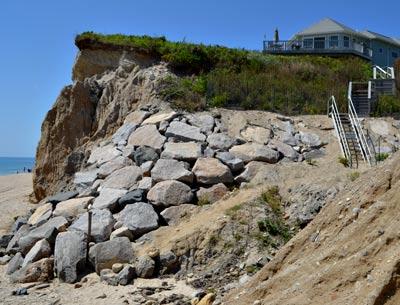Endangered House Decision on Hold

The cliffs of Shadmoor State Park in Montauk and the properties west of it have an almost mystical look, with gullies and hoodoos (tall spires or pyramids) caused by the ocean and rainwater, which eat away at the clay. A jogging and walking path is moved on an almost annual basis, as sections slip down to the beach.
John Ryan is the owner of a 1,800-square-foot, two-story house at the end of Surfside Drive, to the west of the park. He has owned the property since the late 1960s and has watched its 40-foot-tall clay cliffs erode and collapse into the ocean.
On Tuesday, the East Hampton Town Zoning Board of Appeals voted to ask him to submit a detailed environmental analysis of his proposal for a rock revetment under the State Environmental Quality Review Act. The board has already heard about seven hours of public testimony and has a six-inch-thick file on the application.
The decision to seek the environmental impact study is consistent with a request made by Jeremy Samuelson of Concerned Citizens of Montauk at a hearing on July 15, a view that the four members of the board apparently share. (One Z.B.A. member, Lee White, has recused himself.)
The applicant, his representatives, and those who oppose the revetment agree that his house is in danger. After Hurricane Sandy, Mr. Ryan lost almost 30 feet between the house and the abyss, according to his engineer, Drew Bennett. What to do about it, if anything, is the conundrum facing the board.
Mr. Ryan has asked the board to approve a solid revetment 185 feet long with 15 to 25 feet of sloping stone between the cliff wall and the ocean. It would stand 22 feet high and have 10 to 12-ton boulders at its base. Tapered at each end, it would wrap around to the east joining an existing revetment on Mr. Ryan’s property. That structure was built to stop water from running down a gulley to the east of the house, but does not face the ocean.
“This application has a lot of potential environmental impact,” David Lys, a board member, said Tuesday night. Opponents had warned that the revetment would damage the coast in both directions, with properties to the west possibly taking most of the impact.
“More questions were raised than were answered,” another member, Cate Rogers, said. She pointed out that the applicant’s representatives had said the proposed revetment had the potential for scouring the cliffs farther west, andshe said she had found inconsistencies in written statements submitted.
John Whelan, the board’s chairman, emphasized the word “may” several times, saying that the proposed structure “may have a significant environmental impact.”
The positive SEQRA decision was not entirely harmonious. Don Cirillo, who has championed the rights of homeowners to protect their properties, questioned whether other board members had already made up their minds. At one point he pushed for a vote on the application without further study. “What do board members need that we don’t have now?” he asked. “We’re talking about the man potentially losing his house. What are we missing to get to a no or yes vote?”
Ms. Rogers took exception to his repeated assertion that members may already have made of their minds. “I don’t think it is fair for you to say that you know how I’m going to vote,” she said.
In the end, Mr. Whelan guided the board to a 4-0 vote, with Mr. Cirillo joining in. He warned of a potential legal impact were the board to turn down the application without having asked for a full environmental assessment. “For the people of East Hampton, this deserves a full analysis. I haven’t gotten enough information. This is being fair to the applicant. This is giving him the best chance to put his best foot forward. The public has to be involved.”
